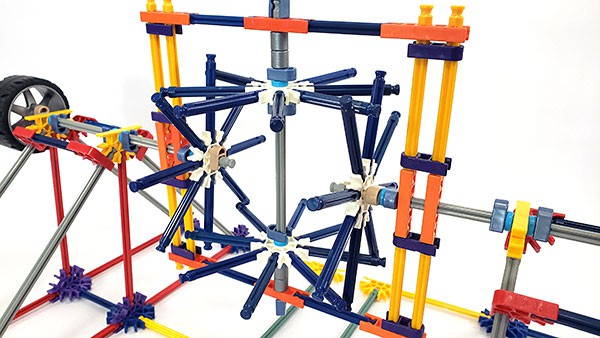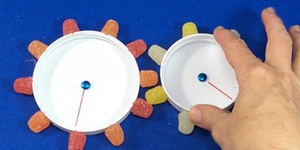Summary
1-2 hours
1-2 hours
Axles, wheels, gears, mechanisms
Ben Finio, PhD, Science Buddies
K’NEX is a registered trademark of Connector Set Limited Partnership.
Introduction
What in the world is a differential and what does it do? A differential is a mechanism that helps cars go around turns without the wheels slipping. In this activity you will build your own working model differential from a building toy like K’Nex®!
Materials
-
Large set of K’Nex® or similar construction toy
-
Alternatively, you could use craft materials like pencils, toothpicks, and cardboard, although this approach may be more difficult.
Instructions
-
Watch this video and follow along to build your own working model differential from K’Nex®. Note that this activity does not provide step-by-step picture instructions like the ones that come with K’Nex sets. You will need to have some experience working with K’Nex, know how to connect the pieces, and know how to build some basic parts (axles, support structures, etc). The steps from the video are outlined below, along with some pictures of the key parts. Note that the structure you build does not need to match the video exactly. This is just one way to build a model differential.
-
Build a support structure to hold two axles. The axles should be aligned with each other, but not connected. Connect a wheel to one end of each axle. The wheel should rotate with the axle, not spin freely on the axle. This picture shows a close-up of the support and axle.
-
Connect a spoke to the other end of each axle. The spoke should rotate with the axle, not spin freely.
-
You can use a bar to push on both spokes at the same time, rotating both wheels. Make sure you have these basic parts working before you proceed.
-
The differential mechanism’s gears are the most complicated part to build. This picture shows a close-up of the gears. Watch the video for step-by-step instructions on how to build this part of the mechanism.
-
Practice using your differential. When the amount of resistance on both wheels is the same, they should spin at the same speed. If you grab one wheel to stop it, the other wheel should keep spinning.
-
Optionally, depending on the K’Nex pieces you have available, you can add a chain drive, a driveshaft, or even a motor to your differential. This picture shows a complete model, including a chain drive and a hand crank.
What Happened?
You should find that when you build a functioning differential mechanism, both wheels will spin at the same speed if the resistance on them is the same. However, both wheels can spin independently when needed. This means the wheels can spin at different speeds—one can spin while the other one is stopped, and they can even spin in opposite directions. However, both wheels can still be driven by a single connection to the axle. In the case of the model demonstrated in the video for this project, that connection was a chain driven by a hand crank. In a real car, that connection would be to a driveshaft which is connected to the engine.
Digging Deeper
When a car goes around a turn, the wheels on the outside of the turn must travel a longer distance in the same amount of time as the wheels on the inside. This means the outer wheels need to rotate faster in order to avoid slipping with respect to the ground. A differential allows both wheels on a powered axle to spin at different speeds. This video provides an excellent explanation of how a differential works and why it is needed:

Ask an Expert
Curious about the science? Post your question for our scientists.
For Further Exploration
- Try adding a chain, driveshaft, or motor to your differential model.
- Try building a working differential from craft materials instead of construction toys.
Activities
STEM Activity
Did you know that gears are all around you? You can find them in wind-up toys, bicycles, carousels, cars and trucks, cranes, drills, wind turbines, analog watches, and so forth! If you’ve looked closely at a moving bicycle, you have seen gears at work. Are you curious about their purpose? In this activity you will use candy to make gears and explore why they are so versatile.
Careers
Career Profile
Cars are an important part of our daily lives. We depend on them to perform everyday tasks—getting to and from school and work, sports practice, grocery shopping, and various errands—and also to keep us safe while doing so. Our cars can keep us cool or warm while we drive them, and they even help us find our way. The automobile is made up of complicated braking, steering, and electrical systems, in addition to the engine and drive train. All of these systems require a tremendous…
Career Profile
There are so many different types of cars and trucks on the road: sports cars, sport utility vehicles (SUVs), pickup trucks, and even electric vehicles and hybrids. Have you ever wondered how they work? And, how to keep them running? How does the engine make a car’s wheels turn? Why does pushing the brake pedal make a car stop? Automotive service technicians (also called mechanics) can pop open the hoods of these different types of cars and answer these questions. Automotive technicians know…
Career Profile
Machinists and tool and die makers set up and operate machine tools to make custom metal parts, instruments and tools. These tools and parts go into machines that are needed to help keep factories and machines running smoothly. A machinist may read drawings or blueprints to set up and operate machine tools. A machinist can monitor machine tools but also can work with their hands to shape parts to specific measurements. A tool and die maker can create and fix metal forms that make metal or…
Explore Our Science Videos
DIY Mini Drone Part 7: Automatic Balancing
Squishy Circuits Classroom Activity Part 1
Make a Lung Model – STEM activity





